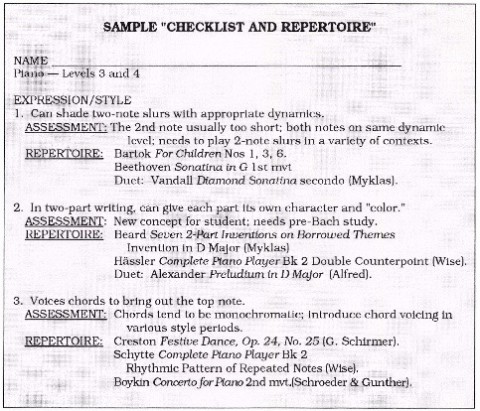We would like to thank Martha Appleby, Sara Krohn, Leanne Hedges, and James B Lyke for this insightful article about planning repertoire. To read the full article, click here.

Although few teachers of my acquaintance indulge in a languid state of inactivity during the summer, it is a time when we re-evaluate the progress of our students during the previous school year and determine what changes to make in the fall. September is the teacher’s New Year with all the feelings of guilt and resolutions for change and, more importantly, the opportunity for change.
How to transform these resolutions into plans and specific repertoire for individual students for the coming school year is the topic to be discussed by the following three experienced teachers. They are sharing with you not only ideas and specifics for this kind of planning, but their commitment to the pedagogical value of learning to assess students’ progress and assign repertoire accordingly.
These words struck fear into my heart!
By Sara Krohn
The words “plan” and “for the year” certainly take a lot for granted, don’t they? These words struck fear into my heart! While staring at the question, I thought about the 16-year-old transfer student I started teaching this year, who after five years of study still needs many first-year fundamentals. My 8-year-old learning-disabled, hyperactive student came to mind. Then the precocious 12-year-old appeared, who after one year of study is playing Clementi sonatinas. What a challenge, to plan in the face of so many variables! A long-term plan—now that’s a challenge which requires time and thoughtful preparation.
I like to think that I manage my time effectively. I plan repertoire for over sixty students in group and individual lessons. Unless I still want to be planning this year’s repertoire next May, I need a system for assessing my students’ skills and assigning their repertoire. So I have created a checklist of essential skills for students at a given level, regardless of age. This gives me a good overview of individual students’ strengths and weaknesses, and helps me design their repertoire over the long term.
I call it my “Checklist and Repertoire” for piano students. This is a form which lists all the skills I consider important for a student at a particular level. The idea is not new; schools have been using an “Individual Educational Plan” (known as an IEP) for years.

The sample below is one part of the “Checklist and Repertoire”. There is a separate page for each of the following areas:
- Rhythm
- Fundamentals/Music
- Theory/Composition
- Technique/Pedal
- Expression/Style
After assessing the student’s level in each area, comments are written beside each of the skills listed. For example, I might write “no knowledge,” “needs my help to do,” or “can do by him/herself.” Space is left to list pieces or exercises which address the particular skill which I feel the student needs to improve. Based on the age and interests of the student, I assign pieces reflecting a variety of styles.
Since no student fits exactly into any given level, each student’s “Checklist” includes earlier levels, as well as the level the student is “supposed” to be in. For example, my 15-year-old transfer student is in level three for most of her skills, but her knowledge of basic chords in level one is poor. By glancing at her “Checklist,” I can see that she missed certain fundamentals along the way, and can address them through appropriate repertoire. Without my “Checklist” I’m sure that I would forget a few areas. With my “Checklist” I know that I am meeting each student’s needs.
We hope you enjoyed this excerpt from Martha Appleby, Sara Krohn, Leanne Stehle Hedges, and James B Lyke’s article about planning student repertoire. You can read the entire article by clicking here.
MORE ON REPERTOIRE PLANNING
- MAGAZINE ARTICLE: What Is Your Favorite Recital Repertoire for 1st-, 2nd-, and 3rd-Year Students? by Martha Appleby, Lisa Bastien Hanss, Helen L. Salay, Lee Evans, and Kathleen Schubert
- COURSES: The Intermediate Course: Continuing Pianistic Growth and Development
- WEBINAR: Purposeful Approaches To Introducing Elementary Repertoire with Sara Ernst
- MAGAZINE ARTICLE: You consistently have high school students that play extremely difficult repertoire such as Chopin Ballades. How do you prepare them to play this difficult repertoire at such a young age? by Nancy Bachus, Paul Wirth, and Donald Morelock
- MAGAZINE ARTICLE: What do you consider when planning and choosing repertoire for students? by Nancy Bachus, Katherine Fisher, Kim Bakkum, and Laurent Boukobza